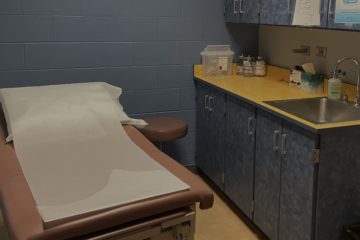West Virginia pediatricians are responding to surges in RSV, Covid-19 and flu cases in children as the state’s pediatric hospital beds have filled up.
The doctors are also on the front lines of responding to the state’s youth mental health crisis. They stand in the gap amid the state’s shortage of mental health care providers and social workers.
“There is an increase in anxiety and depression,” Dr. Jennifer Gerlach, a pediatrician in Huntington who also serves as vice president of the state’s chapter of the American Academy of Pediatrics. “West Virginia does not have enough counselors, psychologists and child psychiatrists to handle the current demand of children that need access to these services.”
Nationally, youth mental health challenges have surged during the pandemic, specifically tied to isolation, stress around health (and family members’ health) and disruption. The federal government has put $280 million toward increasing access to mental health services for kids.
In West Virginia, one of the poorest states with high rates of childhood hunger, childhood obesity and children entering foster care, kids’ mental health hasn’t fared well in the pandemic. And, the state’s rural landscape has left some kids with little to no options of where to turn during a mental health crisis.
“I really try not to send children to the (emergency department) for acute mental health issues. However, there have been a handful of times that there were no other options for an acute mental health emergency,” Gerlach said.
Emergency rooms aren’t meant for child mental health care, but across the country, child visits to the emergency room have increased – jumping 30 percent in 2020 – and so have the wait times for care.
In West Virginia, we don’t know how many kids are using emergency rooms for mental health care, and we don’t know how long those kids wait to be seen by a medical professional or if they even eventually access the appropriate mental health help.
Here’s a quick reminder about why we’re working on this project: We want the state’s emergency rooms to publicly share their data with the goal of understanding how many kids are seeking acute mental health care and what that experience looks like (for example: How long did a kid wait in the emergency room before being transferred to a hospital bed?). This data, stripped of any personal information, could be analyzed for greater understanding of the state’s pediatric mental health needs as well as guide state leaders and lawmakers in decisions about financial resources for kids’ mental health. Other states, like Virginia, make this data publicly available.
Leadership with the West Virginia Poison Control Center, which tracks youth suicide attempts by self-poisoning, has advocated for the release of this data in an effort to address resource gaps. Gerlach said, “This information would be helpful when looking (at) the big picture of children’s mental health in West Virginia.”
I’ve looked at different avenues for collecting this data, but my research and communication with some hospitals have come up short.
Forty states share emergency room data with the Healthcare Cost and Utilization Project’s National Emergency Department Sample, which includes pediatric data, according to its website. West Virginia did not participate in the most recent NEDS report.
West Virginia did share data with the National Ambulatory Medical Care Survey, which reports on the use of medical care services in the United States. Recent reporting in the journal Pediatrics used NAMCS data to show children seeking care in the emergency department for mental health care are at risk for prolonged length of stay. While the Pediatrics article revealed critical gaps in pediatric mental health care, the NAMCS data used for the report was pre pandemic – 2005 to 2015 – and did not break down the data by state. All NAMCS records are completely de-identified for protected health information.
And, the West Virginia Department of Health and Human Resources confirmed it does not have the state’s pediatric emergency room data.
Moving forward, because this project supports transparency and engagement in public mental health surveillance data, I’ve chosen to focus my efforts on hoping to collect the data from two entities: West Virginia University Hospitals and Charleston Area Medical Center.
West Virginia Health Systems oversees 18 hospitals in its expanding network across the state, and they recently announced Thomas Hospital in Charleston will become a full member of the health system at the end of the year. Each of these 18 hospitals list emergency services online, and emergency room data from these 18 emergency rooms would show how often kids from both rural and more populated areas of the state are accessing emergency mental health care.
CAMC includes the state’s largest hospital located in Charleston, and the hospital network. According to its website, the network’s emergency services team handles more than 100,000 emergency room visits each year at its four locations in and around Charleston.
We’ve reached out to WVU Health Systems and CAMC in hopes of acquiring this data, and we will keep you updated on our progress.
If you need help
From parenting support to immediate crisis response, contact 1-844-HELP4WV to talk to a trained helpline specialist who can help you understand options and link you directly to treatment providers. The resource is available 24/7.
You can also get immediate help 24/7 from the National Suicide Prevention Lifeline at 1-800-273-8255.
The West Virginia Department of Health and Human Resources recently launched weekly online sessions for parents and caregivers looking for help navigating child mental health care.




0 Comments